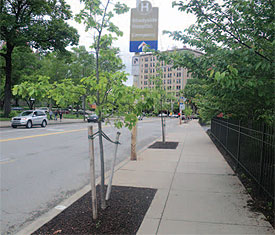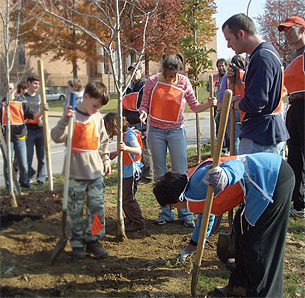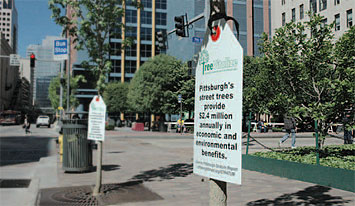Pittsburgh Trees Play Role in Storm Water Management
Pittsburgh is defined by its iconic rivers. However, the city and its surrounding municipalities struggle with managing storm water. Because Pittsburgh has a combined sewer outflow system, excess rainfall mixes directly with sewer water. This combined system becomes overburdened with as little as one tenth of an inch of rain. The average rainfall in Allegheny County is one-quarter inch, so sewer discharges into surrounding waterways occur nearly every time it rains. Untreated sewage has negative impacts on wildlife and water quality as well as restricting rivers for recreational use.

Newly planted trees near Shadyside Hospital.
TreeVitalize Pittsburgh, a unique and effective partnership among nonprofits and government agencies that is housed at the Western Pennsylvania Conservancy’s Pittsburgh office, is playing an increasing role in helping to alleviate this problem.
Since its establishment in 2008, TreeVitalize Pittsburgh has planted more than 6,000 trees in the region toward its goal to plant a total of 20,000 trees by the year 2012.
Most people know that trees serve communities in a number of measurable ways, such as increasing property values and purifying the air. What’s not as well known is that trees’ root systems and canopies help reduce runoff and erosion.
Trees can be especially valuable in cities by helping to compensate for the loss of natural vegetation that occurred during urbanization. Tree canopies and the pits in which they are planted act as a natural defense against flooding by absorbing rainwater and allowing rain to seep naturally into the ground, slowing down storm water runoff and topsoil erosion. By absorbing water, trees help keep urban pollutants from having a direct path to our rivers.

TreeVitalize volunteers help at an East Liberty planting.
“Research by the U.S. Forest Service and universities around the country is increasingly finding that trees provide a variety of environmental and economic benefits including cost-effective storm water management,” said Jeff Bergman, director of TreeVitalize Pittsburgh at WPC. “According to a 2006 study, Pittsburgh’s street tree population provides at least $2.4 million of services to the city annually. One moderately sized street tree can intercept 1,400 gallons of storm water annually, meaning that collectively our street tree population is helping to manage over 40 million gallons of storm water every year.”
TreeVitalize Pittsburgh is a joint project of Allegheny County, the City of Pittsburgh, Friends of the Pittsburgh Urban Forest, PA Department of Conservation and Natural Resources and the Western Pennsylvania Conservancy.

TreeVitalize planted 250 new trees in the Golden Triangle, and hosted a celebration that included a seedling giveaway, in honor of World Environment Day.
Volunteers are integral to the success of TreeVitalize, as all tree planting projects require one certified Tree Tender for every 10 trees planted. Tree Tenders are trained volunteers who are authorized to help plant and maintain small trees. This special group of volunteers participates in a four-session course organized by Friends of the Pittsburgh Urban Forest that equips them with the skills necessary to plant and care for trees. Local tree experts provide instruction, and the course covers everything from tree biology to planting and pruning.
To learn more about becoming a Tree Tender and the benefits that trees provide to communities, please visit the Conservancy’s website at WaterLandLife.org/216.
